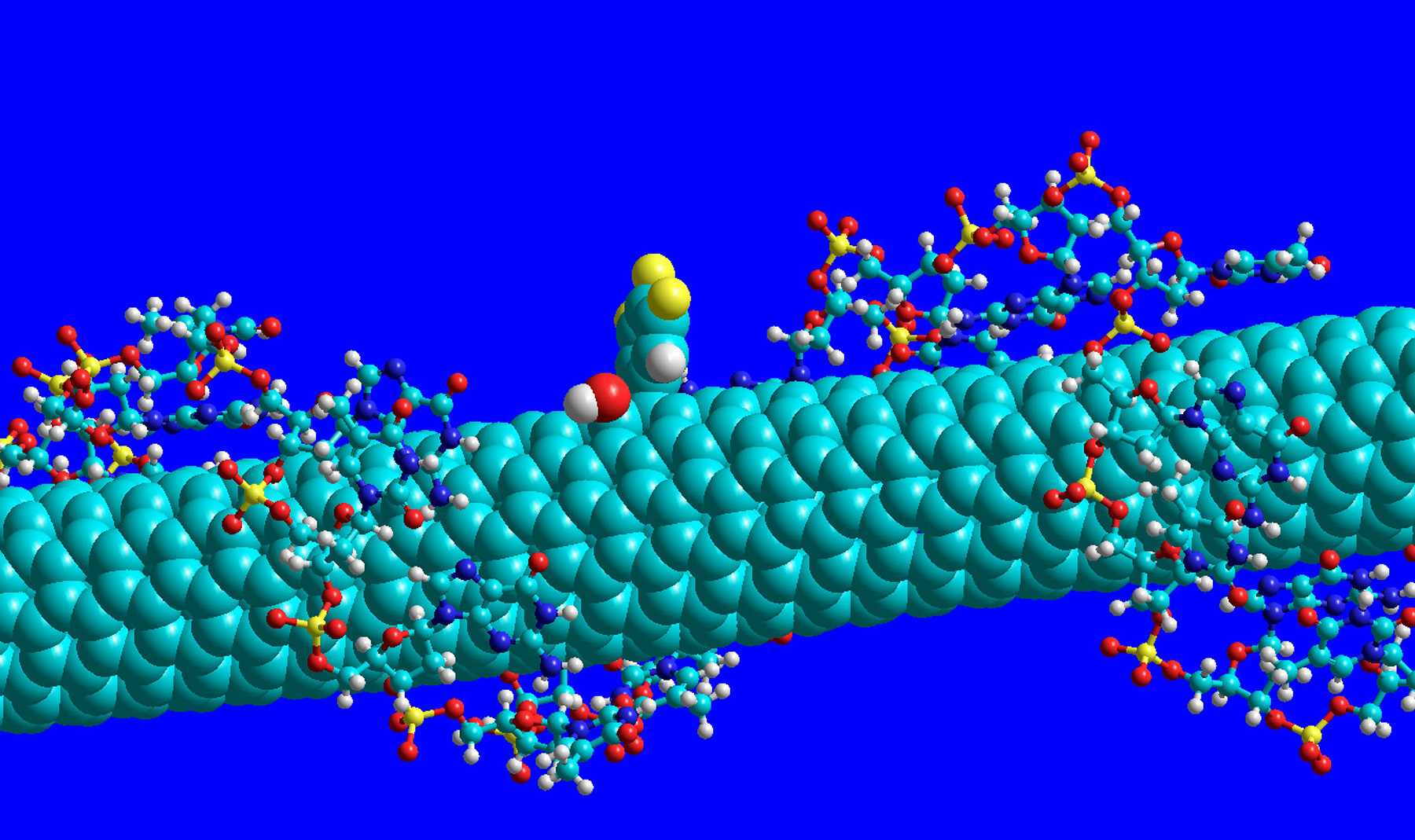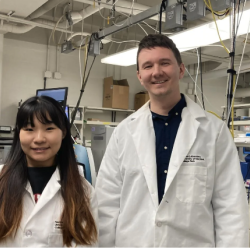Finding the Fingerprint of a Disease

A molecular model of our quantum defect sensor, figure courtesy of YuHuang Wang
A team of researchers including Chemistry and Biochemistry’s YuHuang Wang makes a breakthrough discovery for cancer diagnostics.

Could a single drop of blood hold the key to stopping a dangerous disease? For University of Maryland Chemistry and Biochemistry Professor YuHuang Wang, the answer is a definite “yes”.
Wang is part of a research team that has pioneered a new diagnostic technology capable of detecting the distinct signature of ovarian cancer using just a tiny sample of blood.
“Blood carries the fingerprint of a disease, and our technology reads it,” Wang explained.
Current techniques fall short in diagnosing ovarian cancer before it spreads, but this new discovery by Wang, Mijin Kim (Ph.D. ’18, chemistry), Dan Heller at Memorial Sloan Kettering Cancer Center, Ming Zheng at the National Institute of Standards and Technology, and Anand Jagota at Lehigh University, holds the potential to catch this dangerous disease when it’s most treatable, potentially boosting survival rates. The cutting-edge technology was named this year’s UMD Life Sciences Invention of the Year.
“Receiving this award was truly humbling. We’re grateful that the transformative potential of our work is recognized,” Wang said.
Fifteen years in the making
For Wang, it was a breakthrough discovery more than a decade in the making.
Reflecting on his early years at UMD, Wang recalled the nearly 15 years of intricate work with quantum defects that culminated in this discovery.
“While we were researching chemical defects, we unexpectedly discovered a revolutionary family of quantum emitters and sensors central to this work,” Wang recalled. “However, our breakthrough is not just about mastering defect chemistry. It also intertwines with advancements in cancer diagnostics and machine learning, in which areas we have the privilege to team up with leading experts.”
Beyond quantum defects, detecting cancer has been another key focus of Wang’s research at UMD. As part of a project funded by the National Institutes of Health, Wang looked at the fundamental aspects of chemical detection and specifically how sensor technology might be used to identify the specific signatures of disease. In 2015, when Kim published her first quantum defect research paper as a graduate student in Wang’s group, it captured the attention of scientists at Memorial Sloan Kettering Cancer Center, and a fruitful collaboration was born.
“My former student Mijin Kim was the bridge to this transformative collaboration,” Wang said. “She went on to do a postdoc with my collaborator at Sloan Kettering and brought this team together to really push this research forward.”
An MIT Technology Review 35 Under 35 Awardee, Kim started her own research lab in Georgia Tech’s School of Chemistry and Biochemistry as an assistant professor this fall.
“It is satisfying to see our students charting new paths on their own, and I am certainly very proud of her,” Wang added.
Wang and his collaborators spent years advancing their research, hoping to train quantum defect sensors to recognize the patterns of disease in human blood. Then, in 2021, a breakthrough changed everything.
The ‘aha!’ moment
Wang vividly remembers the ‘aha!’ moment during the pandemic.
“By marrying quantum defects and machine learning, the results outshined contemporary diagnostic tools using a combination of ultrasound and biomarkers. Although we had a feeling it was going to work, we did not expect it to work so well.”
For Wang and his colleagues, this finding opened the door to a new kind of diagnostic technology. The method, akin to nature’s olfactory system, can detect the chemical fingerprint of ovarian cancer in blood, sensing the disease’s unique “pattern of smell.” Wang sees this as just the beginning.
“Its versatility could extend to other diseases in the future,” he predicted.
In this research, the primary target is ovarian cancer, a devastating disease that often spreads before it can be detected. Early detection can increase survival rates from 29% to 90%, a statistic that inspired Wang from the beginning.
“Our choice of ovarian cancer was primarily because it is so difficult to diagnose early,” Wang noted. “Another reason we chose ovarian cancer was because our collaborators at Kettering have access to patient samples and that’s important because we needed a lot of these samples to train our sensors to recognize a pattern of this disease.”
The path ahead
For Wang and his colleagues, receiving UMD’s Life Sciences Invention of the Year award was not just a moment of pride, but a testament to the transformative potential of their research. This recognition, coupled with a new NIH grant the team just received, promises to fuel their innovative work for years to come.
With nearly 15 years of research invested so far and more still ahead, it’s challenging and potentially game-changing work that Wang is excited to continue.
“This new way of detecting disease marks merely the start,” Wang said. “While there’s still a long way ahead, the potential impact of this diagnostics method can be enormous. It’s not just about technology; it’s about saving lives.”
Written by Leslie Miller






